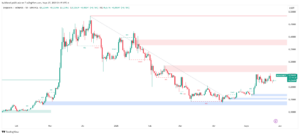
- Base, a popular network built on Ethereum, is rolling out significant upgrades aimed at making transactions much faster and cheaper for users.
- These improvements come as Base’s total value locked (TVL) – the total value of assets held on the network- has reached $4 billion, showing renewed confidence from investors and users.
Base, an Ethereum Layer 2 network developed by Coinbase, is implementing major upgrades to significantly improve its performance. These changes are designed to handle more transactions quickly and cheaply, aiming to make the network more user-friendly and attractive.
What the Base Upgrades Mean
The core goal of these upgrades is to make Base significantly faster and more affordable to use. The plans outlined suggest achieving transaction confirmation times under 200 milliseconds, fees less than one cent per transaction, and processing up to 200 transactions every second.

Beyond just speed and cost, Base is also focusing on creating a fair environment for developers and users, aiming to prevent unfair practices like sandwich attacks, where transactions are unfairly manipulated. Additionally, there are plans to make the network’s underlying structure more decentralised over time, in two separate stages.
Jesse Pollak, who leads Base, even commented on the potential for the network to reach incredibly high speeds in the future, responding “yes” when asked if it could ever handle one million transactions per second. This highlights the long-term ambition for the network’s capabilities.

The timing of these upgrades coincides with a notable increase in the total value of assets locked on the Base network. Base’s TVL recently surpassed $4 billion, reaching a level not seen since late 2024. This surge indicates that investors and users are showing increased trust and are bringing more funds onto the network.
Earlier in 2025, Base’s growth in locked assets had slowed down during a period of uncertainty in the market. However, the increase seen in May suggests that the recent updates and the focus on becoming more decentralised are starting to have a positive effect and attract more activity.
While reaching a high TVL is a good sign, the next challenge for Base is to convert this liquidity into ongoing, active use and attract developers who will build lasting applications on the network. For the growth to be truly sustainable, it needs more than just temporary increases in locked assets; it needs consistent user engagement and organic development.
As of May 2025, Base has emerged as a significant player among Ethereum’s Layer 2 networks. In terms of TVL and the daily number of transactions, Base’s recent growth positions it strongly, putting it ahead of some other well-known competitors in the Layer 2 space, such as Arbitrum and Optimism.
Ethereum is also in the midst of ongoing upgrades aimed at improving scalability. Recent developments, such as the Pectra update, have introduced meaningful enhancements, with future updates like Fusaka expected to further optimise data processing and overall efficiency.
Meanwhile, Base is advancing rapidly with its own targeted performance improvements. By prioritising faster transaction confirmations, lower fees, and a roadmap toward decentralising its core infrastructure, Base is positioning itself as a strong contender in the Layer 2 ecosystem.
With its ambitious performance targets, growing TVL, and focus on decentralisation, Base is aiming to be a major force in making decentralised applications more accessible and efficient for a wider audience, potentially becoming a key player in the future of Ethereum scaling.
The post Base Launches Major Scalability Upgrade – Is It the Next Big Thing in Ethereum Layer 2s? appeared first on ETHNews.

